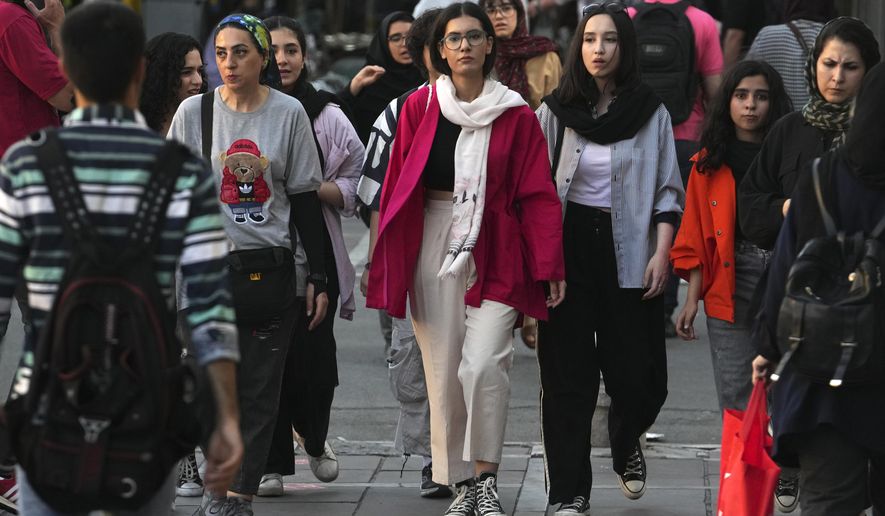OPINION:
“We Iranian girls are not afraid of anything anymore,” shared Maedeh, a brave Iranian woman who spoke with an ABC correspondent, among other women, in a interview without wearing a hijab.
Many of us cannot imagine the reality of oppression so real and so intense that we would be utterly fearless to combat it. Today, Iran’s “morality police” continue to assault, imprison and murder women in cold blood for violating hijab laws. Treated as second-class citizens without autonomy rights, many Iranian women are even used by their husbands, the authorities and other male figures for the purposes of sexual exploitation, oftentimes against their own will.
Subscribe to have The Washington Times’ Higher Ground delivered to your inbox every Sunday.
This is oppression, and it is their reality. Yet, as countless obstacles stand in the way of their freedom, Iranian women fight, unafraid and unashamed, for basic human rights.
During Women’s History Month, it is important to recognize the history that Iranian women are making in this very moment.
Uprising for something greater
Iranian women continue to push back on the regime’s control. It is a true war. As the government’s chokehold tightens on what these women can wear, say and do — including a newly implemented internet directive, further limiting their access to the outside world — these women are taking action. And the whole world is watching.
These women are making history for the culture of Iran at large, as well as for the future of their nation. Prepared to serve as dauntless casualties in the process, Iran women are fighting for more than their own freedoms. Their opposition to the controlling regime is making strides for other subcultures that face similar Iranian oppression — specifically for the vulnerable populations of racial, lingual and cultural minorities.
These groups, while largely unrecognized by the rest of the world, face unfathomable abuses, marginalization and control from the Iranian government and those favored by the regime.
As we bear witness to this pivotal time in Iranian history, we are also privileged to commend these women for all that they are doing for themselves and others in their stance of fearless solidarity.
Fruit of the fight thus far
In this beginning wave of a long-projected battle for freedom, we see promising, historical steps for Iranian women. Following the death of Mahsa Amini, the women of Iran have continued to make international news for nearly two years straight, amplifying the rebellion — alongside the following international accolades: Mahsa Amini winning the European Union’s Sakharov Prize, Narges Mohammadi the Nobel Peace Prize and Nazanin Boniadi the Sydney Peace Prize.
With prominent headline after headline around the globe, the world remains enticed and captivated by the women of Iran. And the tables are turning as the fearful Iranian regime grapples with the question of how to contain this growing movement without losing control over its people.
As women push these boundaries, will the Iranian government concede? We’re already witnessing progress. Just within the last year, women have been permitted to attend professional football games. Perhaps this will be another drop in a flood toward ending the discriminatory control and abuse towards those deemed second-class citizens in Iran.
Honoring the women of Iran
As our thoughts and prayers remain with the Iranian women, so do our hearts of strength and solidarity. Our voices continue to amplify theirs, memorializing those who have given their very lives for this cause and uplifting those continuing in the uprising by making the truth known around the world. We further spur on the movement for these women as well as the rest of Iran in the brave fight for voice and freedom.
We have a humanitarian duty to magnify this reality through social media, in our conversations with others and by supporting organizations that are on the ground in Iran, helping these very women — from activist groups pushing for policy change to ministries and nonprofits striving to ensure these women continue to be heard around the world, diligently working to offer safety, educational resources, opportunities and tangible materials specific to their needs. Now more than ever, we have the optimal chance to help this courageous, strong and yet underprivileged group speak out. Let’s come alongside the women of Iran as they continue making history.
–
Lana Silk serves as Chief Executive Officer (USA) of Transform Iran. She is tri-lingual and considers it her life calling to represent and advocate for the people of Iran in the West. Lana currently lives with her husband and three children in Ohio, actively operating Transform Iran’s mission.




Please read our comment policy before commenting.